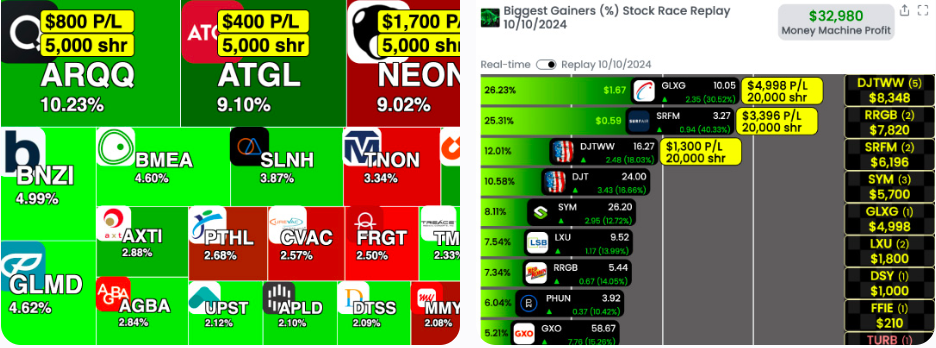20 Pro Suggestions To Picking AI Stock Picker Platform Sites
20 Pro Suggestions To Picking AI Stock Picker Platform Sites
Blog Article
Top 10 Tips To Assess The Strategy Customization Of Ai Stock Trading Platforms
The ability to customize strategies is an essential feature of AI trading platforms that predict and analyze stocks, as it allows users to customize the platform according to their own specific goals in trading as well as their risk tolerance and market conditions. A platform that offers a variety of customizable options can help you improve your trading. Here are the 10 best tips for evaluating the customization options offered by these platforms.
1. Evaluate Pre-Built Strategy Templates
A variety of templates to choose from - Check for built-in strategies that are designed to accommodate different trading styles.
You are able to easily modify the templates and adapt them to your specific needs.
Performance history: Make sure that the platform contains historical data about performance for the strategic plans that have been pre-built.
2. Assess Custom Strategy Creation
Drag-and-drop tools: Choose platforms with drag-and-drop interfaces that permit you to quickly create personalized strategies.
Coding Options: If you are an advanced user, be sure that your platform supports customized coding.
Flexibility. Be sure to identify key elements such as risk management parameters, entry/exit regulations, and any other elements that make up your strategy.
3. Check for Backtesting Capabilities
Historical data: Verify if the platform is able to provide enough historical data for backtesting your strategies.
Customizable Parameters: It is important to be able adjust parameters, including indicators and timeframes during backtesting.
Performance metrics: Ensure that the platform provides detailed metrics of performance (e.g. Win rate Sharpe Ratio, Drawdown) when testing strategies.
4. Evaluate Real-Time Strategy Testing
Paper trading: Check that the platform supports simulation and paper trading modes for testing strategies in real time, without risking your capital.
Live testing is a great method to determine if your strategy can be implemented in the real market with tiny amounts.
Real-time Adjustments: Check whether you can make adjustments in real-time in response to the market conditions.
5. Evaluate the level of integration based on technological indicators
Indicator Library: Determine that the platform includes a library of technical indicator (e.g. moving averages, RSI or MACD).
Custom indicators It is possible to develop or import your own indicators which you can apply to your strategies.
Check if you can combine multiple indicators to create more complicated strategies.
6. Check for Risk Management Tools
Stop-loss/take-profit: Ensure the platform allows you to set stop-loss and take-profit levels within your strategies.
Size of the position: Determine whether you can define rules for position sizing (e.g. an amount fixed or a percentage of the portfolio) to control risk.
Risk-reward-ratio: Verify the support of the platform to set risk/reward ratios for specific trades or trading strategies.
7. Evaluate Multi-Asset Strategy Support
Asset classes: Make sure the platform supports multiple asset classes, like ETFs, stocks and options.
Cross-asset strategies: Determine whether you can create strategies that include various asset classes (e.g. pairs trading or hedges, etc.).
Market coverage: Make sure the platform is covering the markets in which you're interested (e.g. US and international markets and copyright, etc.).
8. Evaluate the automation, Execution and Execution
Automated trading. Make sure the platform supports automated execution based on predefined strategies.
Types of orders - Make sure that the platform supports a variety of order types that can be used to execute strategies (e.g. stop, limit or market).
Check for latency: Make sure that the platform allows for transactions to be completed with minimal latency. This is crucial in the context of high-frequency strategies.
9. Make sure you are using tools to optimize your strategy
Parameter Optimization: Check whether the platform offers tools for optimizing strategies parameters (e.g. genetic algorithms grid search, genetic algorithms).
Machine learning: Ensure the platform is machine learning to help refine and optimise strategies.
Scenario Analysis: Find out whether the platform can test strategies in various markets (e.g. bull bear, bear and volatile).
Review the Community Feedback and User Reviews
Feedback from users is essential to understand the effectiveness of the platform.
Community forums: Find out if there is an active community of users who are willing to share their strategies and ideas.
Support resources - Make sure that the platform provides tutorials and documentation for users to develop and improve strategies.
Bonus Tips
Trial period for free: You can explore the options for customization of the platform with a the demo or trial.
Scalability is important. The platform needs to be able to manage strategies that are more complex as you trade.
Support for customers: Find out if support available for questions or concerns related to strategy.
With these suggestions you will be able to effectively evaluate the ability to tailor strategies for AI trading platforms that predict and analyze stocks and ensure you select a platform that aligns with your objectives in trading and permits you to implement and refine your strategies effectively. A platform with robust customization capabilities will allow you to adapt to market conditions and improve your trading performance. Take a look at the recommended ai stock picker advice for blog advice including using ai to trade stocks, ai investment app, ai trading tools, stock ai, chatgpt copyright, market ai, ai stock trading bot free, ai for investment, best ai trading app, ai stocks and more.
Top 10 Tips To Assess The Risk Management Capabilities Of Ai Stock Prediction/Analyzing Platforms
Any AI stock-predicting/analyzing trading platforms must incorporate risk management that is crucial to safeguard your capital and limiting losses. Platforms with strong risk management tools will help you navigate the turbulent stock markets and make an decisions based on information. Below are the top ten tips to evaluate the risk management capabilities of these platforms:
1. Review Stop-Loss and Take-Profit Features
Configurable settings: Ensure that you set your limit of take-profit or stop-loss for a specific trade.
Make sure that your platform supports trailing stops that adjusts itself automatically in the event that the market moves toward you.
Guaranteed stops: Check whether the platform provides guarantee stop-loss orders. These assure that your trade is completed at the price you specified regardless of market volatility.
2. Utilize Position Sizing Tools
Fixed amount. Make sure you have the option to define your position sizes as the fixed dollar amount.
Percentage of portfolio: Check whether you can establish position sizes in percentages of your portfolio total to reduce risk proportionally.
Risk-reward-ratio: Determine if the platform lets users determine their own risk/reward ratios.
3. Make sure you have Diversification Support
Multi-asset trade: Make sure that the platform supports trading across different asset classes (e.g., ETFs, stocks or forex) to help diversify your portfolio.
Sector allocation: Check if your platform has tools to manage and monitor sector exposure.
Geographic diversification: Check if the platform you trade on supports international markets in order to spread risk across different geographical areas.
4. Review leverage and margin controls
Margin requirements: Make sure the platform discloses clearly any margin requirements when trading leveraged.
Find out whether you are able to set leverage limits in order to limit risk exposure.
Margin calls: Make sure you are receiving prompt notifications from the platform in order to ensure that your account is not liquidated.
5. Assessment Risk Analytics and reporting
Risk metrics - Ensure that your platform includes crucial risk metrics, such as the Sharpe ratio (or Value at Risk (VaR)), or drawdown (or value of the portfolio).
Scenario assessment: See whether you can simulate various scenarios of markets on the platform in order to determine potential risks.
Performance reports: Check whether the platform has specific performance reports with risk-adjusted returns.
6. Check for Real-Time Risk Monitoring
Monitoring your portfolio. Make sure that your platform can track the risk in real-time of your portfolio.
Alerts and notifications - Verify that the platform has sent out alerts at the moment that risk events happen (e.g. margin breaches or triggers for stop-loss order).
Check the risk dashboards. If you're looking to get a full picture of your risks, make sure that they are customizable.
7. How can you assess the results of Stress Testing and Backtesting
Stress testing: Make sure the platform you use allows you to test your strategies or portfolio under extreme market conditions.
Backtesting: Find out if the platform supports backtesting strategies with previous data to evaluate the risk and effectiveness.
Monte Carlo simulators: Verify that the platform uses Monte Carlo to simulate a range of outcomes that could occur in order for you to determine the risks.
8. Risk Management Regulations Compliance Assessment
Regulatory Compliance: Verify the platform's compliance with the relevant Risk Management Regulations (e.g. MiFID II for Europe, Reg T for the U.S.).
The best execution: Make sure that the platform is in line with the most efficient execution methods. Trades will be executed at the most affordable price feasible to limit slippage.
Transparency - Check to see whether the platform has disclosed risks in a clear, transparent manner.
9. Check for User-Controlled Parameters
Custom risk rules - Make sure the platform permits the user to set up your own risk management rules.
Automated Risk Controls: Find out whether the system is able to enforce risk management guidelines that are based on parameters pre-defined.
Manual overrides: Make sure to check whether the platform permits manual overrides of automated risk controls in the event of emergencies.
Review user feedback and case studies
User feedback: Use user reviews to evaluate the platform's ability to manage risk.
Case studies: Look for case studies or testimonials which highlight the platform's capabilities in risk management.
Forums for communities. Find out if the platform is a thriving user-based community where traders share risk management strategies and suggestions.
Bonus Tips
Trial period: Make use of a demo free or trial to test the risk management capabilities of the platform in real-world scenarios.
Customer support: Ensure the platform provides a solid support in relation to risk management concerns or questions.
Look for educational sources.
With these suggestions to evaluate the risks management capabilities of AI trading platforms that predict or analyze stocks and ensure you select the one that can protect your capital and minimize possible losses. The use of robust risk management tools is essential for navigating unstable markets and achieving long-term trading success. Read the top my response for how to use ai for stock trading for more examples including can ai predict stock market, ai share trading, ai stock investing, stock predictor, how to use ai for copyright trading, ai stock trader, best ai stocks, ai share trading, ai stock trader, ai software stocks and more.